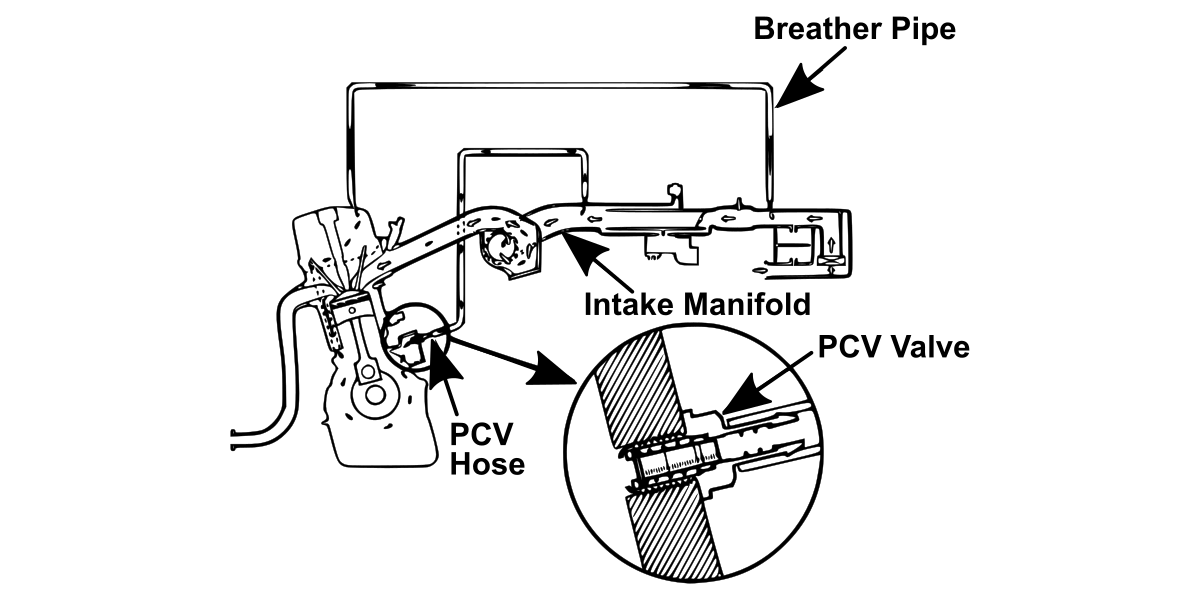You may not think much about the PCV valve—that small, often-overlooked part of your engine—but when it fails, the consequences can be surprisingly serious. In our previous article, we explained what a PCV valve does and why it’s essential to your engine’s health. Now, let’s explore the symptoms of a bad PCV valve and how to diagnose the issue before it turns into an expensive repair.

Table of Contents
ToggleWhy PCV Valves Fail
(PCV Failure Symptoms, Bad PCV Symptoms)
Like any mechanical part, PCV valves wear out over time. Common reasons include:
Carbon buildup or sludge clogging the valve
Internal spring failure, causing the valve to stay stuck open or closed
Cracked or disconnected PCV valve hoses leading to vacuum leaks
Even a small failure in the system can cause noticeable changes in your engine’s performance.
Common Symptoms of a Bad PCV Valve
(Symptoms of a Bad PCV Valve, PCV Valve Symptoms, Signs of a Bad PCV Valve)
🚗 1. Increased Oil Consumption or Leaks
Why it happens: A stuck-closed PCV valve causes crankcase pressure to rise, forcing oil past gaskets and seals.
What you’ll notice: Oil spots under the vehicle, oily residue on engine parts, or frequent low-oil warnings.
🔧 2. Rough Idle or Engine Stalling
Why it happens: A stuck-open valve becomes a vacuum leak, upsetting the air-fuel mixture.
Symptoms: Rough or erratic idle, engine stalling, or hesitation during acceleration.
💡 3. Check Engine Light (CEL)
Why it happens: The engine’s control system detects an issue with air-fuel ratios or vacuum levels.
Common codes: Fuel trim errors, misfire codes (e.g., P0171, P0300).
⛽ 4. Poor Acceleration or Surging
Why it happens: An inconsistent vacuum signal from a faulty PCV valve disrupts fuel delivery.
Symptoms: Jerky acceleration, surging, or delayed throttle response.
🧼 5. Excessive Oil in Air Filter or Intake
Why it happens: Instead of routing blow-by gases properly, a failed PCV valve allows oil mist to enter the intake.
What you’ll see: Oil-soaked air filter, oily throttle body or intake ducts.
🌫️ 6. Black Smoke from Exhaust
Why it happens: A closed or clogged PCV valve enriches the mixture, causing incomplete combustion.
Sign: Thick, dark smoke from the tailpipe, especially on startup or acceleration.
🛢️ 7. Engine Sludge Buildup
Why it happens: Without ventilation, moisture and unburned vapors accumulate, leading to sludge.
How you find out: Often discovered during oil changes or valve cover removal.
🎧 8. Whistling or Hissing Noise
Why it happens: Cracked PCV hoses or a stuck-open valve can allow air to be sucked in abnormally.
Clue: A faint whistle or hiss when the engine is running.
DIY: How to Check Your PCV Valve Safely
(PCV Valve Bad Symptoms Diagnosis)
Before you replace anything, you can perform a few basic tests:
🔄 The Shake Test
Remove the valve.
Shake it — you should hear a metallic rattle. If not, it may be stuck or clogged.
👍 The Thumb Test
With the engine idling, remove the valve from its grommet.
Place your thumb over the open end — you should feel strong suction.
No suction = possibly stuck or damaged.
🛠️ The Oil Cap Test
Slightly loosen the oil cap with the engine running.
If the cap lifts or vibrates due to pressure, your crankcase may be over-pressurized — a red flag for PCV failure.
⚠️ Note: If you’re unsure or uncomfortable, consult a certified mechanic.
What Happens If You Ignore a Bad PCV Valve?
(PCV Valve Bad = Bigger Problems)
A faulty PCV valve can lead to:
🔧 Blown seals and gaskets
🛢️ Accelerated oil sludge buildup
🌍 Increased emissions
⛽ Poor fuel economy
💸 Costly engine repairs, especially if oil contamination leads to worn internals
Conclusion: Stay Ahead of the Symptoms
Your engine’s PCV system may be small, but ignoring its warning signs can cause large-scale engine trouble. If you’re experiencing any of the above bad PCV valve symptoms, act early.
